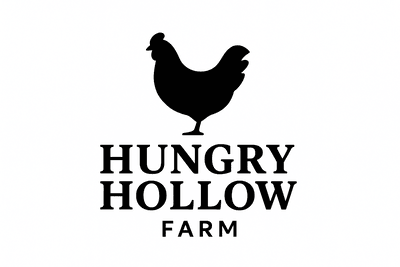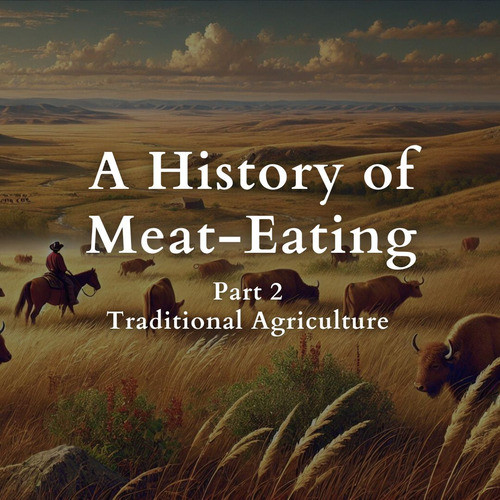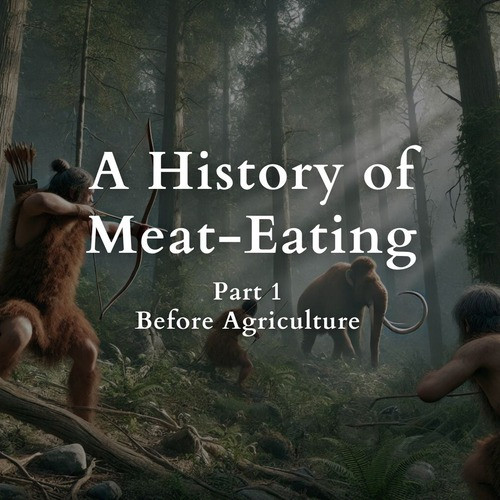From Wilderness to Warehouse: The Decline of Meat in the Modern Age
posted on
April 7, 2024

Walking through the meat aisle of the supermarket, we’re given the illusion of nearly unlimited choice.
But here’s the thing: while it may seem like grocery stores sell every type of meat under the sun, they don’t. In fact, when it comes to meat from land animals, they typically only sell one very particular type of meat: meat produced using industrial agriculture. Wild and pastured meats are notably absent from the shelves.
The prevalence of industrially produced meat is a recent phenomenon. For roughly the first 96.67% of our species’ history, meat always came from wild animals. For the next 3.3%, meat usually came from animals raised using traditional animal husbandry practices. For just the last .03% of our existence — only about 80 years — meat from land animals in the U.S. has come largely from Confined Animal Feeding Operations (CAFOs), also known as factory farms.


This rapid shift and how little it is discussed today should deeply concern us, because how meat is produced substantially affects nutritional value, animal welfare, environmental impact, and working conditions within our food system.
Let’s step back and take a look at the pros and cons of these three distinct categories of meat.
Wild Meat

For approximately 560 million years before humans arrived on the scene, meat was the product of one animal eating another in the wild.2 Going back even further, less complex organisms have been consuming one another for more than 2 billion years.3 All of life has been shaped by complex relationships between predators, prey, and their environment.
Wild animals eat vastly more diverse diets than those raised in agricultural systems. They are also far more active, and their average lifespan is longer. All of these factors influence the nutritional value of their meat. Studies comparing wild elk, deer, and boar meat to meat from the same species raised in captivity have found that “wild game meat fats are more favorable to the human body”.4 Most notable is the low occurrence of unhealthy Omega 6 fats in wild game meats, which are associated with heart disease, inflammatory diseases, and cancer, and the high occurrence of healthy Omega 3 fats, which are essential for brain function.5
Animals that live in the wild produce meat that is more nutritious, and it should come as no surprise that it produces happier animals as well. Wild animals live in environments they’ve evolved to be biologically adapted to over millions of years. They breed naturally and have natural family structures, unlike animals kept in agricultural systems.
Wild animals live in relative harmony with their ecosystem, as their numbers are kept in check by predators. In most ecosystems today, humans play the role of predators of wild game animals as most of their other natural predators have been removed from the landscape. If we stopped hunting today without introducing more predator species, the population of many game species would rise, resulting in ecological damage due to increased grazing pressure and eventually starvation due to limited food stocks. An additional environmental benefit of meat from wild animals is that wild animals don’t require us to ship them feed or use tractors to plant and harvest their food like we do in agriculture, so the greenhouse gas emissions required to eat them are negligible.
Compared to farmed meat, wild meat is much more difficult to obtain. To eat it you’ll need to become an adept hunter or find someone who is. And some may shy away from the flavor of wild meat. As our palates have come to be adapted to a handful of livestock species raised on comparatively bland diets, wild meat can taste “gamey” or be tough to chew for the modern eater.
In summary, wild meat is associated with:
(+) Highest nutritional quality
(+) Highest animal welfare
(+) Lowest ecological footprint
(-) Highest difficulty to obtain
(-) Most expensive
(+/-) Variable flavor; can be delicious, or taste “gamey”
Pastured Meat

About 12,000 years ago, humans began farming rather than depending strictly on hunting and gathering to meet their dietary needs. Most wild animals were unsuitable for domestication due to various characteristics such as size and temperament. However, a few, such as cattle, sheep, goats, pigs, and chickens, were excellent candidates. Today, these species produce nearly all land-based meat that is consumed globally.
Pastured meats come from livestock that are raised outdoors on pastures. While there are a variety of pastured systems, the general principle is that they are moved frequently through fields where they graze on a broad diversity of forages in a way that mimics the behavior of wild animals.
Meat from pastured livestock typically has similar or slightly lower quantities of beneficial Omega 3 fats and micronutrients than wild meat, but significantly more than meat from livestock raised in industrial confinement settings.6,7
On the animal welfare front, pastured livestock are the gold standard of agricultural systems. Much of modern animal welfare work is centered around creating “enrichments” for livestock, and pasture is in many ways the ultimate enrichment. Like wild animals, pastured animals live in environments they're biologically adapted to, and where they can express all of their natural behaviors. For these reasons, pastured livestock are associated with considerably better animal welfare outcomes than livestock raised in confinement.
Pastured livestock play a crucial role in revitalizing degraded farmlands. Since manure was first applied to croplands 8,000 years ago, and until the rise of synthetic fertilizers last century, agricultural systems have almost without exception included livestock for their ability to sustain soil health.8 Animal impact enriches soil health and makes intensive farming in one place over long periods of time feasible.
When it comes to taste, most people find that meat from pastured livestock tastes better than meat from animals raised in confinement. That said, there can still be an adjustment period for those who have only ever eaten industrial meats, particularly for grass-finished beef which varies between producers and reflects the type of forages the animals eat.
While meat from pastured livestock is typically less expensive and easier to obtain than wild meat, it is more expensive than industrial meat. It is also not available at many grocery stores, so consumers often have to do some research and find a local farm that produces pastured meats.
Raising livestock on pastures is associated with optimal working conditions. Pasture farmers enjoy active days outside breathing fresh air while nurturing animals in environments appropriate to each species. As a pasture farmer myself, I can’t imagine raising animals in any other way.
In summary, pastured meat is associated with:
(+) High nutritional quality
(+) High animal welfare
(+) Low ecological footprint
(+) Farmland restoration
(+) Delicious flavor
(+) Best working conditions
(-) Moderately difficult to obtain
(-) Moderately expensive
Industrial Meat

Industrial meat, which has existed for less than 100 years, comes from what are known as Confined Animal Feeding Operations (CAFOs.) On these farms, large quantities of animals are crowded together in a small area and fed bland diets typically consisting of corn and soy. The goal is to produce the highest quantity of meat at the lowest possible cost, despite many tradeoffs for animal welfare, environmental impact, nutritional quality, and working conditions. Because animals kept in these environments are prone to disease, antibiotics are used to keep the animals alive long enough to get them to slaughter weight. Overuse of antibiotics has led to concerns about antibiotic resistant strains of bacteria that can pose threats to human health.9
Of the three types of meat considered here, industrial meat has the lowest nutritional quality. The ratio of unhealthy Omega 6 fats to healthy Omega 3 fats is an important indicator of this. Humans evolved on a diet in which the ratio of Omega 6:3 was about 1:1, but typical Western diets have a ratio of about 15:1.4 Industrial meat is largely to blame for this disparity. Whereas a typical Omega 6:3 ratio for wild meats is 3:1, and for pastured meats is 5:1, industrial meats have a staggeringly high 15:1 Omega 6:3 ratio.4,6,7 As a reminder, high amounts of Omega 6 fats are associated with heart disease and cancer, while Omega 3 fats are associated with healthy cognitive function.
Because nearly every factor of production is controlled, one benefit of industrial meat is that it nearly all tastes the same. This is great for fast food chains that want their hamburgers to taste the same in New York as they do in Tokyo. This homogeneity has another effect that is less immediately obvious: when it all looks, feels, and tastes the same, it’s easier to forget that a piece of meat came from a unique animal raised in poor conditions.
Industrial meat is notoriously associated with abysmal animal welfare. Crowded conditions, poor air quality, and the inability of animals to express many of their natural instincts are just a few of the animal welfare issues that result from industrial meat production.10
Regions containing high concentrations of CAFOs have perennial environmental issues, particularly related to water quality. Manure is often collected in “manure lagoons” and then applied to local farmland. Because the amount of manure produced is many times higher than what can be effectively absorbed by the farmland, excess nutrients end up polluting local waterways.11 These excess nutrients cause marine plants to die, disrupting delicate marine ecosystems and creating dead zones devoid of aquatic life.12
Unsurprisingly, working conditions on industrial animal farms are very poor. Rather than working outdoors and breathing fresh air as they would on pasture farms, workers in CAFOs are forced to endure the same horrible conditions as the animals. Locked in debt, many farmers are stuck in the industrial system with no way out. But there is some good news. Some farmers are getting creative and finding ways to pivot away from factory farming by transitioning their facilities to another product, such as indoor mushroom production or hemp farming. The Transfarmation Project exists to support farmers through these transitions.
In summary, industrial meat is associated with:
(+) Consistent flavor
(+) Easiest to obtain
(+) Least expensive
(-) Lowest nutritional quality
(-) Lowest animal welfare
(-) Highest ecological footprint
(-) Poorest working conditions
(-) Antibiotic use
A Recent Mistake
The choices we make about the meat we consume have far-reaching implications for our health, the welfare of animals, and the health of our planet. The prevailing norm of industrial meat has shaped our perceptions, but it's crucial to recognize that it's the historical exception, not the rule. While the demand for cheap meat has driven its takeover of our food system, we’re now much more aware of the negative impacts it causes. Raising animals on pastures in diverse agricultural systems is gaining traction and scientific credibility as a better way forward.13,14,15
Pastured meats offer nearly all the benefits of wild meat without the downsides of industrial meat, while still being relatively easy to obtain. They enable us to honor the role meat has historically played in our diets and obtain high-value nutrients, without having to take up hunting and head to the woods each fall. There isn’t enough wild meat to support 8 billion humans, but by utilizing pastured livestock to regenerate farmlands we can produce the meat we need as an additional benefit to farmland restoration. For example, over 700 million acres are grazed by cattle in the US. If we added pastured broiler chickens to just 3% of these lands, we could convert 100% of the nearly 9 billion chickens consumed in the U.S. each year from industrial to pastured production while enriching the ecological health and productivity of these farmlands.
Thankfully, the current iteration of our food system is temporary. It's just a recent mistake. Let's build something better.
###
- How many animals are factory farmed? (2023)
- Ancient fossil is earliest known animal predator (2022)
- When was the first time life began to predate on each other? (2022)
- Nutrition Value of Wild Animal Meat (2013)
- The importance of the ratio of omega-6/omega-3 essential fatty acids (2002)
- A review of fatty acid profiles and antioxidant content in grass-fed and grain-fed beef (2010)
- Pasture and Feed Affect Broiler Carcass Nutrition (2015)
- Researchers Discover First Use of Fertilizer (2013)
- Antibiotic Use in Agriculture and Its Consequential Resistance in Environmental Sources: Potential Public Health Implications (2018)
- Farm Animal Welfare and Human Health (2016)
- Agricultural Practices and Nitrate Pollution of Water (2012)
- Agricultural Practices Contributing to Aquatic Dead Zones (2020)
- Ecosystem Impacts and Productive Capacity of a Multi-Species Pastured Livestock System (2020)
- Managing Grazing to Restore Soil Health, Ecosystem Function, and Ecosystem Services (2020)
- Integrating Animal Husbandry With Crops and Trees (2020)
If you enjoyed this article, please consider sharing!
About Hungry Hollow
Hungry Hollow is a diversified farm in Shelton, WA producing pasture-raised meat, eggs, and vegetables. With a focus on animal welfare and ecological stewardship, our work models an alternative to industrial agriculture that is rooted in joy, transparency, and reverence for life.



